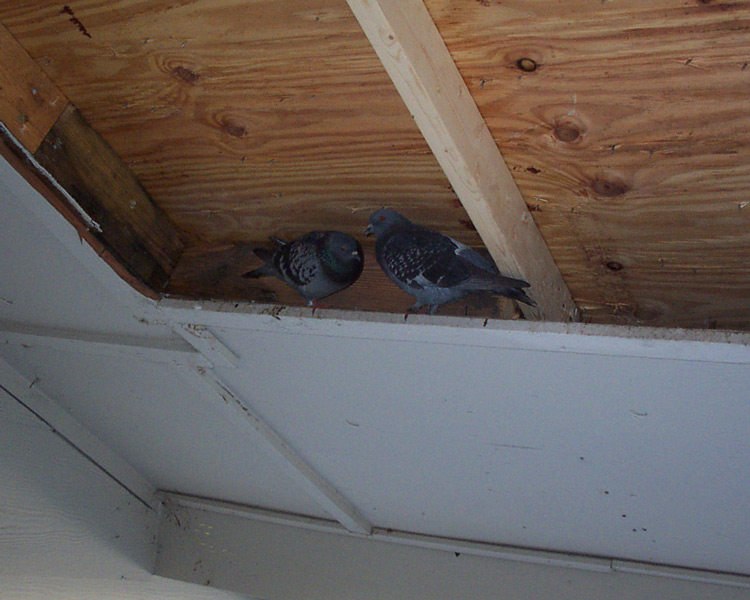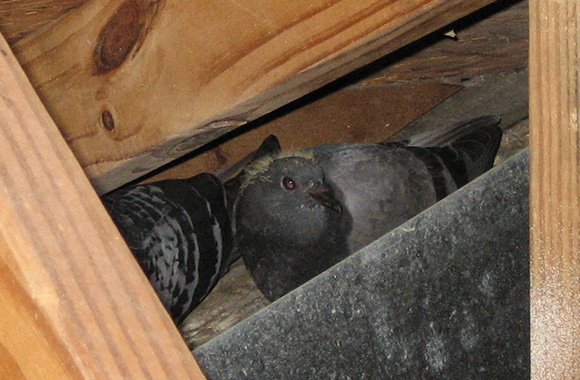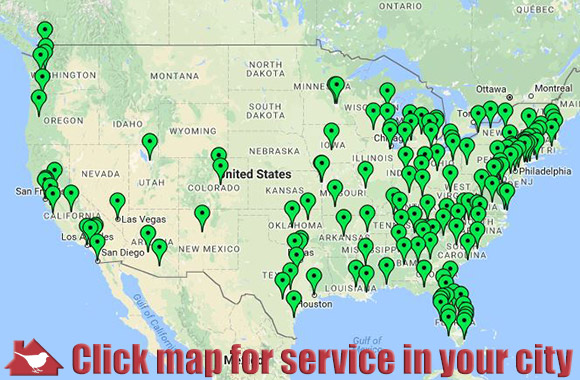How to get birds out of the attic
You take pride in your home and do all you can to keep it clean and pest free. You work hard to keep it looking tidy and in good repair. Despite all your best efforts, you find that you have been invaded. You have discovered birds nesting in your attic. You do not want them there. You know that They can cause massive property damage with their pooping, pecking, and scratching. Feral Birds carry all kinds of diseases, some fatal, that can be transmitted to humans and other animals. Their bodies are littered with mite, fleas and other parasitic muck. They travel in large numbers, make lots of noise, and are copious breeders. Here are a few simple steps you can take to rid your home of pesky birds.
Find out how the birds are getting in.
This important step will help decide the severity of your problem, and determine the most effective means of eradication. No matter how sound the exterior your home may appear, they are gaining entrance
somehow. Birds can fit through very small openings. Until you find all their entryways and seal each hole permanently, you will never rid yourself of these annoying birds! A bird can fit through a tiny space as small as only 4 inches. You must check every crack and
crevice. Inspect the entirety of your roof structure. Examine the ridge row, eaves, and around any chimneys thoroughly. Check around window sills, appliance vents, and siding edges.
The bird's entryways will have a large amount of feathers and feces lying around. Search your attic and crawlspaces for signs of habitation such as feces, feathers, nests, and eggs.
Determine what type of bird you are dealing with
There are literally hundreds of thousands of bird species in the world. Thousands of them are considered a type of nescience bird. It would benefit you to learn what type of bird you have in
your home. Once you have Determined what type of bird you are dealing with, it will be easier to predict its next actions. Get to know that bird’s habits. It will help you identify the problem spots in your house’s façade.
Decide on a plan of action
You have successfully identified the species of bird. You found where they are roosting. You know how they are getting in, and have located all their entry ways. You have checked for nests, eggs, or babies. Now
you must decide; Do you want them to just leave? Should you wait for the young to grow? Do you want to kill them? Are you going to destroy any eggs?
Now that you have decided what to do, How do you go about it?
If you have decided to kill them all, that is pretty straightforward, but it is also illegal and ineffective. Some people choose the lethal choice of gas or poison, with the idea to just block the attic and use poison or gas. Make sure the rest of your home is safe from it, and wait an appropriate amount of time
before entering the space Keep in mind that this method will have you cleaning up the carcasses, and that could take several days. Residual poison could be left in your home, endangering your family and pets. Poison is illegal, and not really effective for birds.
You can choose kill traps. All kill Traps are messy, and the animal usually does not die right away.
If you just want them to leave, the best choice is to exclude them. Exclusion funnels are a good choice to get rid of the birds quickly. You simply install The large end of the funnel over a central hole the birds use regularly
(after sealing the others up). The birds can exit through the bird hole to the outside, but cannot get back in. This effectively forces the birds to go elsewhere. You can even attach a cage to the outside exit of the funnel, and capture them for relocation.
After you are sure all the birds have exited, remove the funnel, and seal up the final hole. Be certain that you have not left any eggs or young behind! That would be an awful fate for a baby bird, and rotting eggs and dead hatchlings create an awful stench.
The birds are all gone... Now what?
Once you are sure that your interloping guests are gone for good, you must clean the area thoroughly to remove any contaminants left behind. Wear gloves and protective clothing and use a disinfecting
cleaner to wash all hard surfaces. Dispose of any cloth or insulation that has been soiled and secure the bags of trash before throwing them out. Take preventative measures to prevent the bird's return. To prevent a return visit, be sure to keep all the possible
entrances to your attic sealed. Make sure any windows have screens. Cover your chimney and stove with wire mesh. Read more about what to do about birds in the chimney. Inspect your siding, windows, roof edges, and attic often. Keep the area around your home free of unkempt shrubs, vines, or bushy trees. Remove sources of
standing water and dense vegetation so that birds are not tempted to move into your home.
Other thoughts on hw to get pigeons out of the attic: There are a number of ways in which you can try to get rid of pigeons out of the attic but I’ll be honest with you upfrontmany homeowners give up and employ someone like me to come and do the job. You can research as many websites as you like but when it comes down to it, experience will always win and it can be an impossible task to get one step ahead of animals such as these, especially with that whole flying advantage. One -way exclusion methods are a great way of getting rid of a wild animal problem, and can be used for pigeons, raccoons, opossums, rats, squirrels, bats and plenty others. Using a one-way wire funnel, or a one-way door, you can make sure the animals get out but can’t get back in again, something often very preferable to trapping. With trapping you then have the problem of what to do with the animal once you’ve successfully captured it. There are so many laws you need to follow also. Although there are other ways of dealing with a pigeon problem, one-way exclusion is the best way because it forces them to find a new home naturally, and without dumping them into a territory they won’t know and would probably die in.

There are a number of approaches you can try to get birds out of the attic. Waiting for them to leave without intervention is not an option; birds can stay for many months once they have found a safe place to roost or nest. Ideally, you will want to remove the nuisance birds from your attic, and seal it up, before they have the opportunity to consider your home as their home, too.
Does your attic have windows? You can start by opening them and removing any screens that cover them. Light will drive out birds who flock to your attic because it is a dark and safe space. You can also hurry things along by adding a radio or similar. Again, when the birds use your attic for a quiet place, incorporating noise and disturbances can help to drive them away.
These methods will work for a short time, but only temporarily. As soon as you close the windows, make things dark again, and take away the music or disturbance, the birds will likely come right back. To ensure this doesn't happen, you will need to properly seal holes, areas of damage or weakness, and other methods of entry. If the birds can't physically get inside the building, they can't roost or nest there, or cause problems there. Sealing the attic properly and effectively will also prevent other nuisance wildlife problems. If the entrance holes are big enough for a bird to be able to squeeze through, they'll be big enough for other critters to squeeze through.



